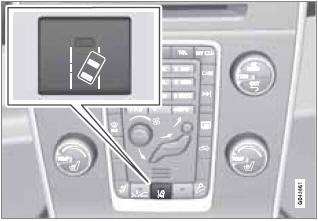Operation and function


LDW can be switched on or off by pressing the button on the center console. A light in the button illuminates when the function is on.
The trip computer display shows Lane Depart Warn Standby <40 mph (Lane Depart Warn Standby <65 km/h) when the function is in standby mode.
When LDW is in standby mode, the function is activated automatically after the camera has monitored the road’s side marker lines and the vehicle’s speed exceeds 40 mph (65 km/h).
Lane Depart Warn Available will be displayed.
If the vehicle’s speed falls below 37 mph (60 km/h), LDW will return to standby mode and Lane Depart Warn Standby <40 mph (65 km/h) will be displayed.
If the camera can no longer monitor the road’s side marker lines, Lane Depart Warn Unavailable will be displayed.
If the vehicle unexpectedly crosses the lane’s left or right side marker lines, the driver will be alerted by an audible signal.
No warning signal will be given in the following
situations:
• The turn signal is being used
• The driver’s foot is on the brake pedal
• The throttle pedal is pressed quickly
• If the steering wheel is moved quickly
• In sharp turns that cause the vehicle’s body to sway
See page 176 for information on the camera’s limitations.
WARNING
The driver will only be warned once for each
time the wheels cross a marker line. No
alarm will be given if a marker line is
between the wheels.
See also:
Weights
...
Electric parking brake
An electric parking brake has the same function
as a manual parking brake.
NOTE
• A faint sound from the parking brake's
electric motor can be heard when the
parking brake is being applied. Th ...
